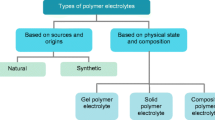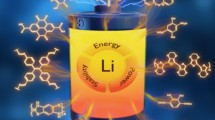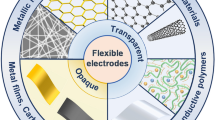Abstract
In this work, the “functionalization-polymerization” (FP) method has been used to construct fullerene-contained double-cable conjugated polymers with “donor-acceptor” backbones. It was realized via synthesizing a fullerene-contained monomer and performing Stille polymerization. With this method, a series of double-cable conjugated polymers with different fullerene contents were developed and applied into single-component organic solar cells. The power conversion efficiencies (PCEs) based on these polymers increased from 0.71% to 1.71% with the enhanced fullerene contents. The relatively low PCEs might be originated from the poor microstructure in these polymers. These new conjugated polymers with molecular heterojunction would show potential application in organic electronic devices.
Similar content being viewed by others
References
Ma, W.; Yang, C.; Gong, X.; Lee, K.; Heeger, A. J. Thermally stable, efficient polymer solar cells with nanoscale control of the interpenetrating network morphology. Adv. Funct. Mater. 2005, 15, 1617–1622.
Cheng, Y. J.; Yang, S. H.; Hsu, C. S. Synthesis of conjugated polymers for organic solar cell applications. Chem. Rev. 2009, 109, 5868–5923.
Dou, L.; Liu, Y.; Hong, Z.; Li, G.; Yang, Y. Low-bandgap near-IR conjugated polymers/molecules for organic electronics. Chem. Rev. 2015, 115, 12633–12665.
Yang, H.; Wu, Y.; Dong, Y.; Cui, C.; Li, Y. Random polymer donor for high-performance polymer solar cells with efficiency over 14%. ACS Appl. Mater. Interfaces 2019, 11, 40339–40346.
Howard, J. B.; Thompson, B. C. Design of random and semi-random conjugated polymers for organic solar cells. Macromol. Chem. Phys. 2017, 218, 1700255.
Wu, M.; Shi, L.; Hu, Y.; Chen, L.; Hu, T.; Zhang, Y.; Yuan, Z.; Chen, Y. Additive-free non-fullerene organic solar cells with random copolymers as donors over 9% power conversion efficiency. Chin. Chem. Lett. 2019, 30, 1161–1167.
Wu, Y.; Guo, J.; Wang, W.; Chen, Z.; Chen, Z.; Sun, R.; Wu, Q.; Wang, T.; Hao, X.; Zhu, H.; Min, J. A conjugated donor-acceptor block copolymer enables over 11% efficiency for single-component polymer solar cells. Joule 2021, 5, 1800–1815.
Xu, W.; Zhang, M.; Xiao, J.; Zeng, M.; Ye, L.; Weng, C.; Zhao, B.; Zhang, J.; Tan, S. Improved photovoltaic properties of pm6-based terpolymer donors containing benzothiadiazole with a siloxane-terminated side chain. Polym. Chem. 2020, 11, 6178–6186.
Lee, Y.; Gomez, E. D. Challenges and opportunities in the development of conjugated block copolymers for photovoltaics. Macromolecules 2015, 48, 7385–7395.
Schraff, S.; Maity, S.; Schleeper, L.; Dong, Y.; Lucas, S.; Bakulin, A. A.; von Hauff, E.; Pammer, F. All-conjugated donor-acceptor block copolymers featuring a pentafulvenyl-polyisocyanide-acceptor. Polym. Chem. 2020, 11, 1852–1859.
Bendejacq, D.; Ponsinet, V.; Joanicot, M.; Airiau, M. Chemical tuning of the microphase separation in diblock copolymers from controlled radical polymerization. Macromolecules 2003, 36, 7289–7295.
Yang, C.; Lee, J. K.; Heeger, A. J.; Wudl, F. Well-defined donor-acceptor rod-coil diblock copolymers based on P3HT containing C60: the morphology and role as a surfactant in bulk-heterojunction solar cells. J. Mater. Chem. 2009, 19, 5416–5423.
Wang, J.; Higashihara, T. Synthesis of all-conjugated donor-acceptor block copolymers and their application in all-polymer solar cells. Polym. Chem. 2010, 4, 5518–5526.
Rahmanudin, A.; Yao, L.; Sekar, A.; Cho, H. H.; Liu, Y.; Lhermitte, C. R.; Sivula, K. Fully conjugated donor-acceptor block copolymers for organic photovoltaics via Heck-Mizoroki coupling. ACS Macro Lett. 2019, 8, 134–139.
Park, C. G.; Park, S. H.; Kim, Y.; Nguyen, T. L.; Woo, H. Y.; Kang, H.; Yoon, H. J.; Park, S.; Cho, M. J.; Choi, D. H. Facile one-pot polymerization of a fully conjugated donor-acceptor block copolymer and its application in efficient single component polymer solar cells. J. Mater. Chem. A 2019, 7, 21280–21289.
Park, S. H.; Kim, Y.; Kwon, N. Y.; Lee, Y. W.; Woo, Han, Y.; Chae, W. S.; Park, S.; Cho, M. J.; Choi, D. H. Significantly improved morphology and efficiency of nonhalogenated solvent-processed solar cells derived from a conjugated donor-acceptor block copolymer. Adv. Sci. 2020, 7, 1902470.
Roncali, J.; Grosu, I. The dawn of single material organic solar cells. Adv. Sci. 2019, 6, 1801026.
Liang, S.; Jiang, X.; Xiao, C.; Li, C.; Li, W. Double-cable conjugated polymers with pendant rylene diimides for single-component organic solar cells. Acc. Chem. Res. 2021, 54, 2227–2237.
Yamamoto, S.; Yasuda, H.; Ohkita, H.; Benten, H.; Ito, S.; Miyanishi, S.; Tajima, K.; Hashimoto, K. Charge generation and recombination in fullerene-attached poly(3-hexylthiophene)-based diblock copolymer films. J. Phys. Chem. C 2014, 118, 10584–10589.
Pierini, F.; Lanzi, M.; Nakielski, P.; Pawłowska, S.; Urbanek, O.; Zembrzycki, K.; Kowalewski, T. A. Single-material organic solar cells based on electrospun fullerene-grafted polythiophene nanofibers. Macromolecules 2017, 50, 4972–4981.
Iftikhar, S.; Aslam, S.; Butt, N. Z.; Ashraf, R. S.; Yameen, B. Prato reaction derived polythiophene/C60 donor-acceptor double cable polymer, fabrication of photodetectors and evaluation of photocurrent generation. J. Mater. Chem. C 2020, 8, 17365–17373.
Chen, P.; Nakano, K.; Suzuki, K.; Hashizume, D.; Koganezawa, T.; Tajima, K. Organic solar cells with controlled nanostructures based on microphase separation of fullerene-attached thiophene-selenophene heteroblock copolymers. ACS Appl. Mater. Interfaces 2017, 9, 4758–4768.
Miyanishi, S.; Zhang, Y.; Hashimoto, K.; Tajima, K. Controlled synthesis of fullerene-attached poly(3-alkylthiophene)-based copolymers for rational morphological design in polymer photovoltaic devices. Macromolecules 2012, 45, 6424–6437.
Miyanishi, S.; Zhang, Y.; Tajima, K.; Hashimoto, K. Fullerene attached all-semiconducting diblock copolymers for stable single-component polymer solar cells. Chem. Commun. 2010, 46, 6723–6725.
Tan, Z.; Hou, J.; He, Y.; Zhou, E.; Li, Y. Synthesis and photovoltaic properties of a donor-acceptor double-cable polythiophene with high content of C60 pendant. Macromolecules 2007, 40, 1868–1873.
He, Y.; Li, N.; Brabec, C. J. Single-component organic solar cells with competitive performance. Org. Mater. 2021, 03, 228–244.
Roncali, J. Single material solar cells: The next frontier for organic photovoltaics? Adv. Energy Mater. 2011, 1, 147–160.
Yu, P.; Feng, G.; Li, J.; Li, C.; Xu, Y.; Xiao, C.; Li, W. A selenophene substituted double-cable conjugated polymer enables efficient single-component organic solar cells. J. Mater. Chem. C 2020, 8, 2790–2797.
Jiang, X. D.; Yang, J. J.; Karuthedath, S; Li, J.; Lai, W.; Li, C.; Xiao, C.; Ye, L.; Mai, Z.; Tang, Z.; Laquai, F.; Li, W. Miscibility-controlled phase separation in double-cable conjugated polymers for single-component organic solar cells with efficiencies over 8%. Angew. Chem. Int. Ed. 2020, 59, 21683–21692.
Yang, F.; Li, J.; Li, C.; Li, W. Improving electron transport in a double-cable conjugated polymer via parallel perylenetriimide design. Macromolecules 2019, 52, 3689–3696.
Liang, S.; Xu, Y.; Li, C.; Li, J.; Wang, D.; Li, W. Realizing lamellar nanophase separation in a double-cable conjugated polymer via a solvent annealing process. Polym. Chem. 2019, 10, 4584–4592.
Feng, G.; Li, J.; He, Y.; Zheng, W.; Wang, J.; Li, C.; Tang, Z.; Osvet, A.; Li, N.; Brabec, C. J.; Li, Y.; Yan, H.; Li, W. Thermal-driven phase separation of double-cable polymers enables efficient single-component organic solar cells. Joule 2019, 3, 1765–1781.
Yang, F.; Wang, X.; Feng, G.; Ma, J.; Li, C.; Li, J.; Ma, W.; Li, W. A new strategy for designing polymer electron acceptors: electronrich conjugated backbone with electron-deficient side units. Sci. China Chem. 2018, 61, 824–829.
Lai, W.; Li, C.; Zhang, J., Yang, F.; Colberts, F. J. M.; Guo, B.; Wang, Q. M.; Li, M.; Zhang, A.; Janssen, R. A. J.; Zhang, M.; Li, W. Diketopyrrolopyrrole-based conjugated polymers with perylene bisimide side chains for single-component organic solar cells. Chem. Mater. 2017, 29, 7073–7077.
Feng, G.; Li, J.; Colberts, F. J. M.; Li, M.; Zhang, J.; Yang, F.; Jin, Y.; Zhang, F.; Janssen, R. A. J.; Li, C.; Li, W. “Double-cable” conjugated polymers with linear backbone toward high quantum efficiencies in single-component polymer solar cells. J. Am. Chem. Soc. 2017, 139, 18647–18656.
Li, S.; Yuan, X.; Zhang, Q.; Li, B.; Li, Y.; Sun, J.; Feng, Y.; Zhang, X.; Wu, Z.; Wei, H.; Wang, M.; Hu, Y.; Zhang, Y.; Woo, H. Y.; Yuan, J.; Ma, W. Narrow-bandgap single-component polymer solar cells with approaching 9% efficiency. Adv. Mater. 2021, 33, 2101295.
Liu, Y.; Liu, B.; Ma, C. Q.; Huang, F.; Bo, Z. Recent progress in organic solar cells (part i material science). Sci. China Chem. 2022, 65, 224–268.
He, Y.; Heumüller, T.; Lai, W.; Feng, G.; Classen, A.; Du, X.; Liu, C.; Li, W.; Li, N.; Brabec, C. J. Evidencing excellent thermal- and photostability for single-component organic solar cells with inherently built-in microstructure. Adv. Energy Mater. 2019, 9, 1900409.
Xie, C. C.; Jiang, X. D.; Zhu, Q. L.; Wang, D.; Xiao, C.; Liu, C.; Ma, W.; Chen, Q.; Li, W. Mechanical robust flexible single-component organic solar cells. Small Methods 2021, 5, 2100481.
Benincori, T.; Brenna, E.; Sannicolò, F.; Trimarco, L.; Sozzani, P.; Zotti, G. The first “charm bracelet” conjugated polymer: an electroconducting polythiophene with covalently bound fullerene moieties. Angew. Chem. Int. Ed. 1996, 35, 648–651.
Jousselme, B.; Blanchard, P.; Levillain, E.; de Bettignies, R.; Roncali, J. Electrochemical synthesis of C60-derivatized poly(thiophene)s from tailored precursors. Macromolecules 2003, 36, 3020–3025.
Cravino, A.; Zerza, G.; Maggini, M.; Bucella, S.; Svensson, M; Andersson, M. R.; Neugebauer, H.; Sariciftci, N. S. A novel polythiophene with pendant fullerenes: toward donor/acceptor double-cable polymers. Chem. Commun. 2000, 2487–2488.
Cravino, A.; Zerza, G.; Neugebauer, H.; Maggini, M.; Sariciftci, N. S. Electrochemical and photophysical properties of a novel polythiophene with pendant fulleropyrrolidine moieties: toward “double cable” polymers for optoelectronic devices. J. Phys. Chem. B 2002, 106, 70–76.
Ramos, A. M.; Rispens, M. T.; van Duren, J. K.; Hummelen, J. C.; Jassen, R. A. J. Photoinduced electron transfer and photovoltaic devices of a conjugated polymer with pendant fullerenes. J. Am. Chem. Soc. 2001, 123, 6714–6715.
Zhang, F. L.; Svensson, M.; Andersson, M. R.; Maggini, M.; Inganäs, O. Soluble polythiophenes with pendant fullerene groups as double cable materials for photodiodes. Adv. Mater. 2001, 13, 1871–1871.
Jia, J.; Huang, Q.; Jia, T.; Zhang, K.; Zhang, J.; Miao, J.; Huang, F.; Yang, C. Fine-tuning batch factors of polymer acceptors enables a binary all-polymer solar cell with high efficiency of 16.11%. Adv. Energy Mater. 2022, 12, 2103193.
Wang, J.; Jiang, X.; Wu, H., Li, J.; Yi, Y.; Feng, X.; Ma, Z.; Li, W.; Vandewal, K.; Tang, Z. Increasing donor-acceptor spacing for reduced voltage loss in organic solar cells. Nat. Commun. 2021, 12, 6679.
Jiang, X. D.; Yang, J. J.; Karuthedath, S; Li, J.; Lai, W.; Li, C.; Xiao, C.; Ye, L.; Mai, Z.; Tang, Z.; Laquai, F.; Li, W. Miscibility-controlled phase separation in double-cable conjugated polymers for single-component organic solar cells with efficiencies over 8%. Angew. Chem. Int. Ed. 2020, 59, 21683–21692.
Acknowledgments
This study was financially supported by Beijing Natural Science Foundation of China. (No. JQ21006) and the National Natural Science Foundation of China (Nos. 92163128, 52073016, 51773207, 21905018 and 21905158) of China. This work was further financially supported by the Fundamental Research Funds for the Central Universities (Nos. buctrc201828 and XK1802-2), the opening Foundation of State Key Laboratory of Organic-Inorganic Composites, Beijing University of Chemical Technology (No. oic-202201006), and Jiangxi Provincial Department of Science and Technology (No. 20192ACB20009).
Author information
Authors and Affiliations
Corresponding authors
Additional information
Notes
The authors declare no competing financial interest.
Electronic Supplementary Information for
Rights and permissions
About this article
Cite this article
Liu, BQ., Xu, YH., Liu, F. et al. Double-Cable Conjugated Polymers with Fullerene Pendant for Single-Component Organic Solar Cells. Chin J Polym Sci 40, 898–904 (2022). https://doi.org/10.1007/s10118-022-2732-2
Received:
Accepted:
Published:
Issue Date:
DOI: https://doi.org/10.1007/s10118-022-2732-2




